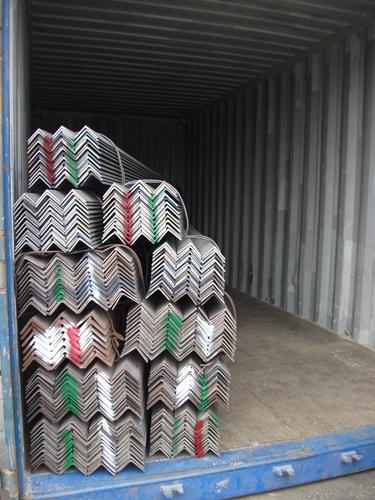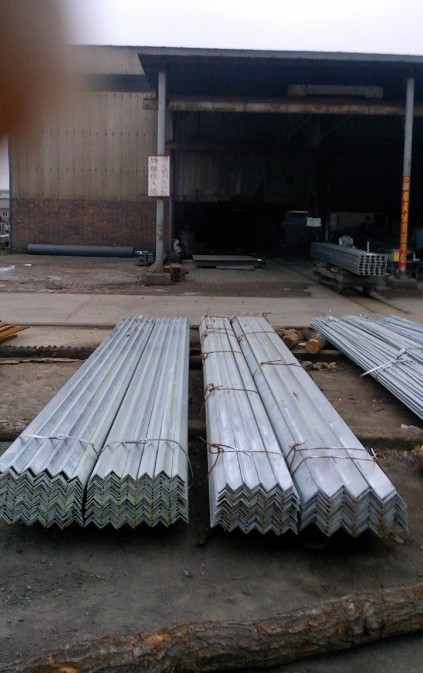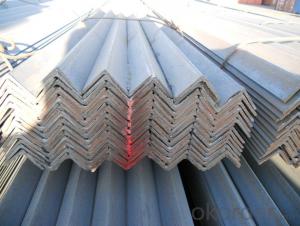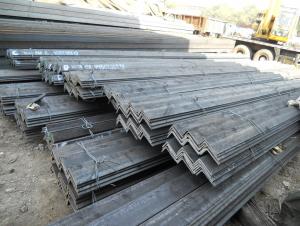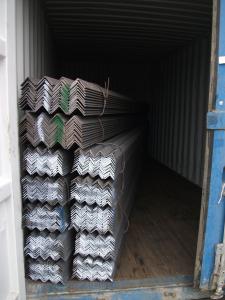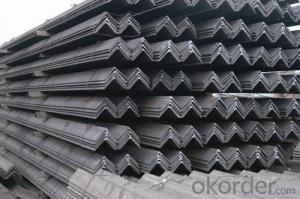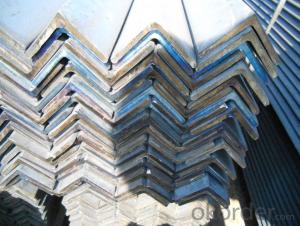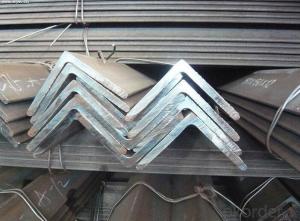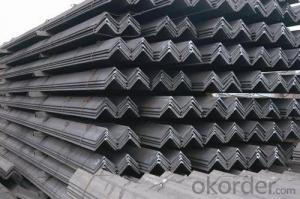Equal Steel Angle Bar
- Loading Port:
- China Main Port
- Payment Terms:
- TT OR LC
- Min Order Qty:
- -
- Supply Capability:
- -
OKorder Service Pledge
OKorder Financial Service
You Might Also Like
Specifications of Angle Steel
1. Invoicing on theoretical weight or actual weight as customer request.
2. Length: 6m, 9m, 12m.
3. Sizes:
| Size(mm) | Mass(Kg/m) | Size(mm) | Mass(Kg/m) |
| 40*40*3 | 1.852 | 45*45*4 | 2.736 |
| 40*40*4 | 2.422 | 45*45*5 | 3.369 |
| 40*40*5 | 2.976 | | |
Payment terms:
1).100% irrevocable L/C at sight.
2).30% T/T prepaid and the balance against the copy of B/L.
3).30% T/T prepaid and the balance against L/C.
Material details:
Alloy No | Grade | Element (%) | | ||||
C | Mn | S | P | Si | | ||
| | |||||||
|
|
|
|
|
|
| |
Q235 | B | 0.12—0.20 | 0.3—0.7 | ≤0.045 | ≤0.045 | ≤0.3 | |
|
|
|
|
|
|
| |
Alloy No | Grade | Yielding strength point( Mpa) | | ||||
Thickness (mm) | | ||||||
≤16 | >16--40 | >40--60 | >60--100 | | |||
≥ | | ||||||
|
|
|
|
|
| | |
Q235 | B | 235 | 225 | 215 | 205 | | |
Alloy No | Grade | Tensile strength (Mpa) | Elongation after fracture (%) | | |||
Thickness (mm) | | ||||||
| ≤16 | >16--40 | >40--60 | >60--100 | | ||
≥ | | ||||||
|
|
|
|
|
|
| |
Q235 | B | 375--500 | 26 | 25 | 24 | 23 | |
*If you would like to get our price, please inform us the size, standard/material and quantity. Thank you very much for your attention.
- Q: Can steel angles be painted over?
- Yes, steel angles can be painted over. Prior to painting, it is important to clean and prepare the surface by removing any rust, dirt, or grease. Applying a primer will help improve adhesion and longevity of the paint. Once the primer is dry, a suitable paint can be applied to achieve the desired finish and protect the steel angles from corrosion.
- Q: Can steel angles be used for soundproofing applications?
- Steel angles are not typically used for soundproofing applications. Soundproofing materials are chosen based on their ability to absorb, dampen, or block sound waves. Steel angles, being a rigid and reflective material, do not possess these sound-dampening qualities. Instead, materials such as acoustic foam, mass-loaded vinyl, or soundproof drywall are commonly used for soundproofing purposes. These materials are specifically designed to absorb or block sound waves, helping to reduce noise transmission between spaces. Therefore, while steel angles may have various applications in construction and engineering, they are not suitable for soundproofing purposes.
- Q: What are the common standards and specifications for steel angles?
- The common standards and specifications for steel angles vary depending on the application and the country in which they are being used. However, some widely recognized standards and specifications include: 1. ASTM A36/A36M: This is a standard specification for carbon structural steel, including steel angles. It covers shapes such as angles, channels, and beams, and specifies the chemical composition, mechanical properties, and other relevant requirements. 2. ASTM A529/A529M: This specification covers high-strength carbon-manganese steel shapes, including angles, used in construction. It provides requirements for chemical composition, mechanical properties, and other important characteristics. 3. ASTM A572/A572M: This specification covers high-strength low-alloy structural steel shapes, including angles. It specifies the chemical composition, mechanical properties, and other relevant requirements for these shapes used in construction applications. 4. EN 10056: This European standard specifies the tolerances on shape, dimensions, and mass of hot-rolled structural steel equal and unequal angles. It provides requirements for the chemical composition, mechanical properties, and other characteristics of steel angles. 5. JIS G3192: This Japanese industrial standard specifies the dimensions, mass, and tolerances for hot-rolled steel sections, including angles. It sets forth the requirements for chemical composition, mechanical properties, and other relevant specifications. These are just a few examples of the commonly used standards and specifications for steel angles. It is important to consult the specific regulations and standards applicable to the region and application in order to ensure compliance and meet the desired requirements.
- Q: What are the limitations of using steel angles in corrosive or saltwater environments?
- The use of steel angles in corrosive or saltwater environments is limited due to their susceptibility to corrosion. Steel is primarily composed of iron, which can react with oxygen and water to form iron oxide, commonly known as rust. In the presence of corrosive substances or saltwater, this corrosion process is accelerated. One limitation is the potential for accelerated corrosion in these environments. Corrosion weakens the structural integrity of the steel angles, which can compromise the overall stability and safety of any structure they are used in. This can be particularly concerning in applications where the steel angles are load-bearing or subjected to significant stress. Another limitation is the decrease in the lifespan of steel angles in corrosive or saltwater environments. The ongoing corrosion process can significantly reduce the lifespan of the steel angles, leading to more frequent maintenance or replacement requirements. This can result in higher costs and potential disruptions to operations or projects. Furthermore, the appearance of the steel angles can be negatively affected by corrosion in corrosive or saltwater environments. Rust stains can develop on the surface of the steel, which can be aesthetically unappealing, especially in applications where the steel angles are visible. To overcome these limitations, alternative materials can be considered for corrosive or saltwater environments. Stainless steel, for example, contains a high proportion of chromium, which provides it with enhanced corrosion resistance. Additionally, protective coatings or treatments, such as galvanizing or epoxy coatings, can be applied to steel angles to provide an additional barrier against corrosion. Overall, while steel angles are versatile and widely used in various applications, their use in corrosive or saltwater environments is limited due to their susceptibility to corrosion. It is crucial to carefully evaluate the specific environment and consider alternative materials or protective measures to ensure the longevity and integrity of any structure or project.
- Q: Can steel angles be used in electrical grounding applications?
- Yes, steel angles can be used in electrical grounding applications. Steel angles are commonly used in construction for their strength and durability. In electrical grounding applications, steel angles can be used to create grounding grids or grounding systems. These grids or systems help to prevent electrical shock hazards by providing a low-resistance path for electrical currents to flow to the ground. Steel angles are often used as structural components in these grounding systems due to their ability to withstand physical stress and their conductive properties. However, it is important to ensure that the steel angles are properly installed and connected to the electrical system in accordance with relevant codes and standards to ensure effective grounding and safety.
- Q: What is the typical width of a steel angle?
- The intended use and project requirements play a significant role in determining the typical width of a steel angle. However, steel angles come in various sizes and dimensions overall. Typically, the width of a steel angle can vary from 1 inch to 8 inches or even more. To ensure the right width for a particular application, it is crucial to refer to the applicable industry standards and specifications.
- Q: What are the weight per meter calculations for steel angles?
- The weight per meter of steel angles relies on the angle's dimensions and the density of the steel employed. To compute the weight per meter of a steel angle, one must be aware of its dimensions, specifically the thickness, width, and length. The weight per meter can be determined using the following formula: Weight per meter = (Thickness x Width x Length) x Density The density of steel fluctuates based on the type of steel employed. The most commonly used steel for angles is mild steel, which has a density of about 7.85 g/cm³ or 7850 kg/m³. For instance, suppose we possess a steel angle with a thickness of 10 mm, a width of 100 mm, and a length of 1 meter (1000 mm). Utilizing the formula and assuming a density of 7850 kg/m³, the weight per meter would be: Weight per meter = (10 mm x 100 mm x 1000 mm) x 7850 kg/m³ Weight per meter = 10,000,000 mm³ x 7850 kg/m³ Weight per meter = 78,500,000,000 mm³/kg To convert the weight to a more common unit, dividing by 1,000,000 would yield the weight per meter in kilograms: Weight per meter = 78,500,000,000 mm³/kg / 1,000,000 Weight per meter = 78,500 kg/m Thus, the weight per meter of this steel angle would amount to 78,500 kilograms.
- Q: How do you protect steel angles from abrasive wear?
- One way to protect steel angles from abrasive wear is by applying a protective coating or finish, such as paint or a specialized protective coating. This ensures that the steel surface is shielded from direct contact with abrasive materials, reducing the risk of wear and tear. Additionally, using rubber or plastic covers or linings on the steel angles can provide an extra layer of protection against abrasive substances. Regular maintenance and inspection to identify any signs of wear and promptly address them can also help prolong the lifespan of steel angles.
- Q: Can steel angles be cut to custom lengths?
- Yes, steel angles can be cut to custom lengths.
- Q: How do you determine the required angle length for a specific application?
- There are several factors that need to be taken into account when determining the necessary length of an angle for a specific application. Firstly, it is important to identify the purpose of the angle in the application. Will it be used for structural support, bracing, or as a decorative element? This will help determine the level of strength and stability required, which will then influence the length of the angle. Next, it is necessary to assess the load or weight that the angle will need to bear. Understanding the amount of force or pressure that will be applied to the angle will assist in determining the appropriate length. A heavier load may require a longer angle to effectively distribute the weight and prevent bending or failure. The material of the angle is another crucial consideration. Different materials have varying levels of strength and durability. For instance, steel angles are stronger than aluminum angles. The properties of the material, such as tensile strength and resistance to corrosion, will impact the required length for the specific application. Furthermore, the specific geometry and configuration of the application should be taken into account. Factors like the overall dimensions, desired angle of inclination, and any additional supports or attachments must be considered. These factors may affect the length needed to ensure proper fit, function, and stability. Lastly, it is important to consult industry standards and regulations to guarantee compliance and safety. Certain applications may have specific guidelines for the length of angles to be used, particularly in fields like construction or engineering. In conclusion, determining the necessary length of an angle for a specific application requires a comprehensive analysis of the purpose, load, material, geometry, and relevant standards. Seeking advice from experts or engineers in the field can also provide valuable insights and guidance.
Send your message to us
Equal Steel Angle Bar
- Loading Port:
- China Main Port
- Payment Terms:
- TT OR LC
- Min Order Qty:
- -
- Supply Capability:
- -
OKorder Service Pledge
OKorder Financial Service
Similar products
Hot products
Hot Searches
Related keywords



